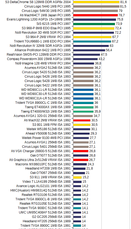At this point, we could as well include PGA, 8514/A and XGA or XGA-2.
"The 8514 had used a standardised API called the "Adapter Interface" or AI.
This interface is also used by XGA, IBM Image Adapter/A, and clones of the 8514/A and XGA such as the ATI Technologies Mach 32 and IIT AGX.
The interface allows computer software to offload common 2D-drawing operations (line-draw, color-fill, and block copies via a blitter) onto the hardware.
This frees the host CPU for other tasks, and greatly improves the speed of redrawing a graphics visual (such as a pie-chart or CAD-illustration).[2][3]
Hardware-level documentation of the XGA was also made, which had not been available for the 8514/A.[3]"
https://en.wikipedia.org/wiki/Extended_Graphi … _Array#Features
To my understanding, though, 8514/A was about the only one to have mattered in practice.
It was being supported by OS/2 1.x out-of-box, for example.
There also was a Mahjongg game for DOS using it.
Edit: Borland's BGI had an 8514/A driver (IBM8514.BGI), too.
Not sure if it had any acceleration, though.
http://www.thealmightyguru.com/Wiki/index.php … phics_Interface
TIGA was really fascinating, but required a DOS driver tied to a specific graphics board.
The TIGA setting in Windows 3 Setup merely is an middle-ware thing talking to the DOS driver.
8514/A was a bit different, since it had software emulators, too.
Some driver disks of the overly popular ET4000 card comes with such an emulator, for example.
XGA and XGA-2 were never really important, outside of a corporate environment, I assume.
It had been hyped for a year or two in magazines of the early 90s, then went away.
PGA had been used in the 80s, apparently, but it had been very niche, too.
A few VGA or Super EGA cards or CAD graphics cards had incorporated the functionality of it.
Except for that 8086 code execution feature. A real IBM PGA could run 8086 code, due to its 8088 processor.
"Time, it seems, doesn't flow. For some it's fast, for some it's slow.
In what to one race is no time at all, another race can rise and fall..." - The Minstrel
//My video channel//

